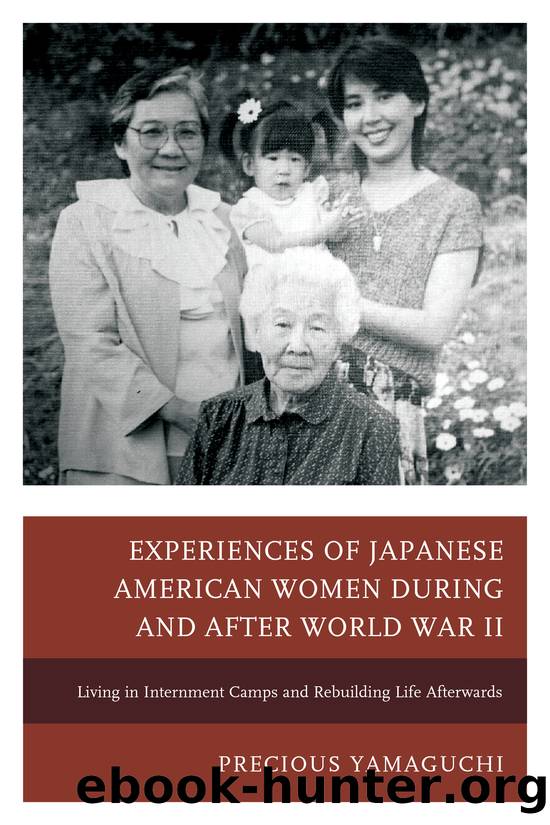Experiences of Japanese American Women during and after World War II by Precious Yamaguchi

Author:Precious Yamaguchi
Language: eng
Format: epub
Publisher: Lexington Books
Life Inside the Internment Camps
On December 7, 1941, the Japanese military attacked Pearl Harbor. Two months after the attack on February 19, 1942, President Franklin Roosevelt issued Executive Order 9066 that gave the United States Army permission to exile Japanese Americans from the west coast and relocate them into internment camps. Any Japanese American living on the west coast, who possessed one-eighth blood of Japanese ancestry was put into relocation camps in remote areas of the United States away from the Pacific coast. They were kept unaware by the government about how long their stay in the camp would be and if they would ever be released from the internment camp.
Yoshi: Working in the Poston Internment Camps
Yoshi, a Japanese American woman, and her family were forced to leave beautiful Oceanside, California, and she and her family were relocated to Poston, Arizona. Her memories include the following details:
I remember when we left Oceanside by train and then we had to take a bus to Poston, by the time we got there and signed in, it was already dark. When I think about that, I donât know how we ever got to our little room. There was no lighting. We were out in the beaten sun, in the desert, so we had to carry our luggage, and 18 is an age where I would say, you knew what was going on but didnât really understand the circumstances. When we first went to camp, we were all looking for some kind of work in the camp. A lot of us worked in the canteen or mess hall with my friends. Of course we hated that job and then we eventually went to different kinds of jobs. I started working for the hospital as a nurseâs aide. Camp life was pretty miserable. But I guess we learned to appreciate the hardship.
Like several of the Japanese American women interviewed in this book, the women would say similar statements similar to Yoshiâs proclamation, âCamp life was pretty miserable. But I guess we learned to appreciate the hardship.â The women would state an honest truth about their challenges and struggles, but then follow it with a positive statement. If I were to have interviewed them several decades ago, I wonder how they would have told their stories? Would they still have stated a negative truth, followed by a positive statement? Sometimes, it would be the opposite pattern, where a positive statement was made, followed by a negative, such as, âCamp wasnât so bad. But it really hurt me to see that my country did not see me as an American.â This reflects a common display of how the Japanese Americans, both women and men, who I interviewed spoke about their experiences.
Japanese American families tried to stay together in the camps and create communities and activities in the internment camps such as classrooms, baseball teams, dance classes, and music performances. They lived in barracks and weather-proofed their living conditions when it snowed in the winters or became blistering hot in the summers.
Download
This site does not store any files on its server. We only index and link to content provided by other sites. Please contact the content providers to delete copyright contents if any and email us, we'll remove relevant links or contents immediately.
| Americas | African Americans |
| Civil War | Colonial Period |
| Immigrants | Revolution & Founding |
| State & Local |
In Cold Blood by Truman Capote(3274)
Steve Jobs by Walter Isaacson(2804)
The Innovators: How a Group of Hackers, Geniuses, and Geeks Created the Digital Revolution by Walter Isaacson(2711)
All the President's Men by Carl Bernstein & Bob Woodward(2304)
Lonely Planet New York City by Lonely Planet(2143)
And the Band Played On by Randy Shilts(2090)
The Room Where It Happened by John Bolton;(2074)
The Poisoner's Handbook by Deborah Blum(2068)
The Murder of Marilyn Monroe by Jay Margolis(2033)
The Innovators by Walter Isaacson(2007)
Lincoln by David Herbert Donald(1925)
A Colony in a Nation by Chris Hayes(1834)
Under the Banner of Heaven: A Story of Violent Faith by Jon Krakauer(1720)
Amelia Earhart by Doris L. Rich(1621)
The Unsettlers by Mark Sundeen(1619)
Dirt by Bill Buford(1585)
Birdmen by Lawrence Goldstone(1571)
Zeitoun by Dave Eggers(1565)
Being George Washington by Beck Glenn(1497)
